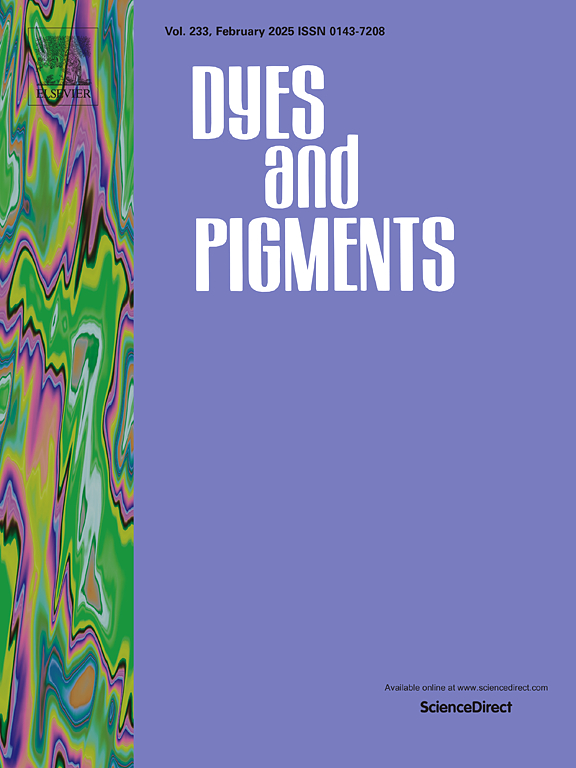Imidazolium salt end-capped arylene diimides for good solubility, low driving voltage and excellent cycling stability in semi-solid hydrogel-state electrochromic devices
IF 4.1
3区 工程技术
Q2 CHEMISTRY, APPLIED
引用次数: 0
Abstract
Arylene diimide derivatives possess good redox activity owing to their rigid planar conjugated structure and strong electron-deficient aromatic nuclei, but poor solubility and high working voltage limit their practical applications in electrochromic field. In this paper, benzene and naphthalene-based arylene diimides end-capped with imidazolium salts, PMDI-M-C4 and NDI-M-C4, were synthesized and used as the electrochromic materials in both solution- and semi-solid hydrogel-state electrochromic devices. The introduction of imidazolium salts greatly improved their solubility in polar solvents including water, methanol, dimethyl sulfoxide, etc. In solution-state electrochromic devices, both of them showed a moderate working voltage, high optical contrasts (>50 %), high coloration efficiencies (>300 cm2/C), fast switching times (<2 s) and good cycling stability. They showed different colored state due to different aromatic cores, and NDI-M-C4 with a larger conjugation degree core of naphthalene exhibited better cycling stability. In semi-solid carboxymethyl cellulose sodium hydrogel-state electrochromic devices, similar colored states were observed whereas the working voltage was markedly reduced. It's noteworthy that semi-solid hydrogel-state electrochromic device based on NDI-M-C4 performed best with the lowest working voltage of −0.8 V, a high optical contrast of 48.3 %, the best cycling stability and satisfactory coloration efficiency. Finally, the applications of the semi-solid hydrogel-state electrochromic devices in various electronic displays were demonstrated, and its design concept and successful exploration have widely promising applications in displays, adaptive camouflage, bionics, and so on.

在半固体水凝胶状态电致变色器件中,咪唑盐端封芳烯二亚胺具有良好的溶解性、低驱动电压和优良的循环稳定性
芳二亚胺衍生物由于其刚性的平面共轭结构和强的缺电子芳核而具有良好的氧化还原活性,但其溶解度差和工作电压高限制了其在电致变色领域的实际应用。本文合成了端部为咪唑盐的苯基和萘基芳烃二亚胺PMDI-M-C4和NDI-M-C4,并将其作为电致变色材料应用于溶液和半固体水凝胶状态的电致变色器件中。咪唑盐的引入大大提高了其在水、甲醇、二甲基亚砜等极性溶剂中的溶解度。在溶液态电致变色器件中,两者都表现出中等的工作电压、高光学对比度(> 50%)、高显色效率(>300 cm2/C)、快速开关时间(< 2s)和良好的循环稳定性。由于芳香族核的不同,它们呈现出不同的色态,而萘核共轭度较大的NDI-M-C4具有较好的循环稳定性。在半固体羧甲基纤维素钠水凝胶状态电致变色器件中,工作电压明显降低,但也观察到类似的色态。值得注意的是,基于NDI-M-C4的半固态水凝胶态电致变色器件表现最佳,其最低工作电压为−0.8 V,光学对比度高达48.3%,循环稳定性最佳,显色效率令人满意。最后,介绍了半固态水凝胶态电致变色器件在各种电子显示器中的应用,其设计理念和成功探索在显示、自适应伪装、仿生学等方面具有广泛的应用前景。
本文章由计算机程序翻译,如有差异,请以英文原文为准。
求助全文
约1分钟内获得全文
求助全文
来源期刊

Dyes and Pigments
工程技术-材料科学:纺织
CiteScore
8.20
自引率
13.30%
发文量
933
审稿时长
33 days
期刊介绍:
Dyes and Pigments covers the scientific and technical aspects of the chemistry and physics of dyes, pigments and their intermediates. Emphasis is placed on the properties of the colouring matters themselves rather than on their applications or the system in which they may be applied.
Thus the journal accepts research and review papers on the synthesis of dyes, pigments and intermediates, their physical or chemical properties, e.g. spectroscopic, surface, solution or solid state characteristics, the physical aspects of their preparation, e.g. precipitation, nucleation and growth, crystal formation, liquid crystalline characteristics, their photochemical, ecological or biological properties and the relationship between colour and chemical constitution. However, papers are considered which deal with the more fundamental aspects of colourant application and of the interactions of colourants with substrates or media.
The journal will interest a wide variety of workers in a range of disciplines whose work involves dyes, pigments and their intermediates, and provides a platform for investigators with common interests but diverse fields of activity such as cosmetics, reprographics, dye and pigment synthesis, medical research, polymers, etc.
 求助内容:
求助内容: 应助结果提醒方式:
应助结果提醒方式:


